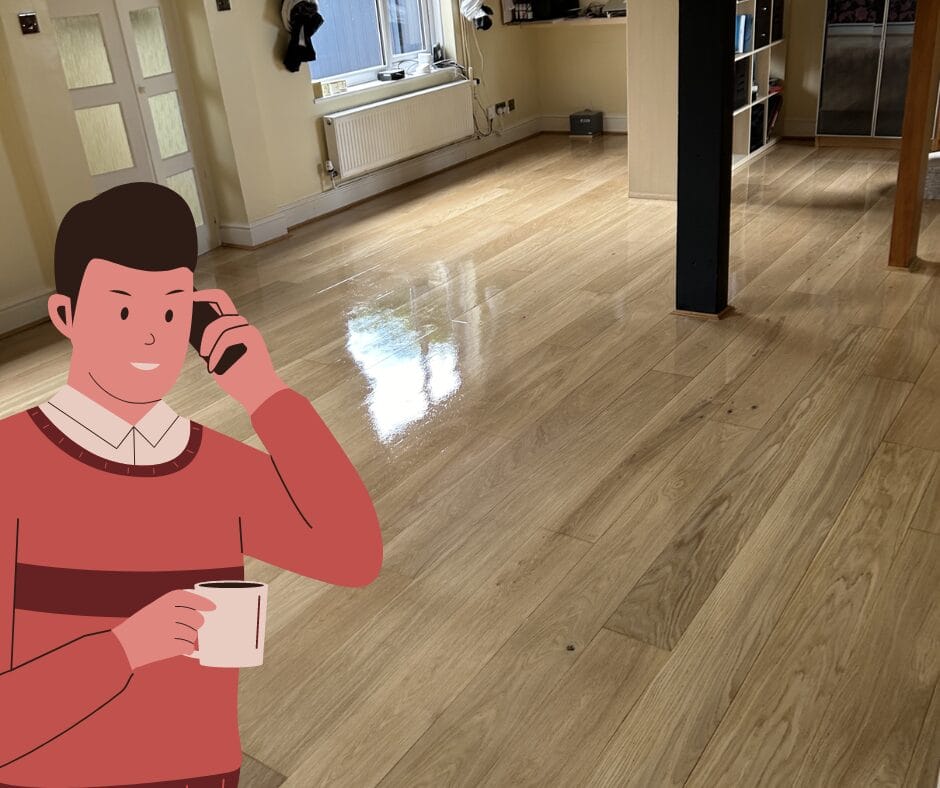Hello, loyal reader—and a big welcome if you’re new here! If you’re dealing with sticky wood floors, you’re not alone. It’s a common issue, and if you’ve been scrubbing away with no luck, don’t worry—we’ve got your back. Today, we’re talking about why wood floors get sticky (especially after using bleach) and what you can actually do about it—without making things worse!
Why Do Wood Floors Get Sticky?
Wood floors should feel smooth and clean underfoot, so if yours feel tacky or sticky, something has gone wrong. And if you’ve used bleach, that “something” is probably a chemical reaction messing with your floor’s finish.
Let’s break it down:
Bleach Strips the Finish – Bleach is a powerful chemical, but it doesn’t play nicely with wood floor finishes. It can break down the protective coating, leaving behind a sticky residue that won’t just mop away.
Residue Buildup – Even if you think you’ve rinsed it off, bleach (and other harsh cleaners) can leave behind a thin film that makes floors feel tacky. Over time, this attracts dirt, making the problem even worse.
Moisture Issues – Wood doesn’t like excess moisture. If you’ve over-wetted your floor while cleaning, it can absorb moisture and temporarily feel sticky. Over time, too much water exposure can cause long-term damage.
So, what’s the solution? Step away from the vinegar and DIY hacks you might have seen online—we’ve got a better way!
How to Fix Sticky Wood Floors (The Right Way)
We’ve seen all sorts of DIY suggestions floating around, like vinegar solutions or fancy chemical neutralisers. But honestly? We wouldn’t recommend them. Vinegar, for example, is acidic and can damage your floor’s finish, making things worse in the long run.
Instead, here’s the safe, no-fuss way to get your floors back to normal:
Use a Damp (Not Wet!) Cloth – A simple wipe with a slightly damp microfiber cloth is often enough to remove surface residue. The key is to avoid over-wetting the wood, as too much moisture can cause damage.
Stick to pH Neutral Cleaners – Bleach, vinegar, and all-purpose cleaners are too harsh for wood floors. Instead, use a pH-neutral wood floor cleaner that’s designed to clean without damaging the finish.
Mop with the Right Products – If you’re using a spray mop, make sure the cleaning solution is safe for wood floors. Brands like Pallmann and Bona make great options specifically designed to clean without leaving residue or damaging the finish.
By following these simple steps, you’ll avoid making the problem worse and keep your wood floors looking their best.
When a Simple Clean Isn’t Enough…
If you’ve tried cleaning and your floor is still sticky, it might mean the finish itself is compromised. In that case, no amount of wiping will fix the problem. That’s when it’s time to consider sanding and refinishing.
Here’s why that might be the best solution:
Removes the Damaged Finish – Sanding strips away the sticky top layer, giving you a fresh, clean surface.
Restores the Floor’s Natural Beauty – Once the old finish is gone, we apply a new, protective layer that brings back the original look and feel of your floor.
Long-Term Protection – A professional refinish ensures your wood floor is protected for years to come.
If you’re unsure whether sanding is needed, a professional inspection can help you decide the best course of action.
Keeping Your Wood Floors in Top Condition
Now that your floors are back to normal, let’s keep them that way! Cleaning regularly with the correct products will help stop future issues. Here are some tried-and-tested favourites:
Pallmann Clean Neutral Cleaner – A gentle, pH-neutral cleaner perfect for everyday use. Safe, effective, and no sticky residue.
Bona Premium Spray Mop – A quick and easy way to clean wood floors without over-wetting them.
Using the right cleaners means you won’t have to deal with sticky floors in the future, and your wood will stay looking great for years to come.
Final Thoughts (Because We Don’t Do “Conclusions” Here!)
Sticky wood floors are annoying, but the fix is simple: avoid bleach, ditch the vinegar, and clean with the right products. If cleaning doesn’t work, refinishing might be the answer. Either way, we’re here to help!
Got questions or need expert advice? Reach out to Floor Sanding Newmarket… we’d love to help you enjoy your beautiful wood floors to the fullest!



